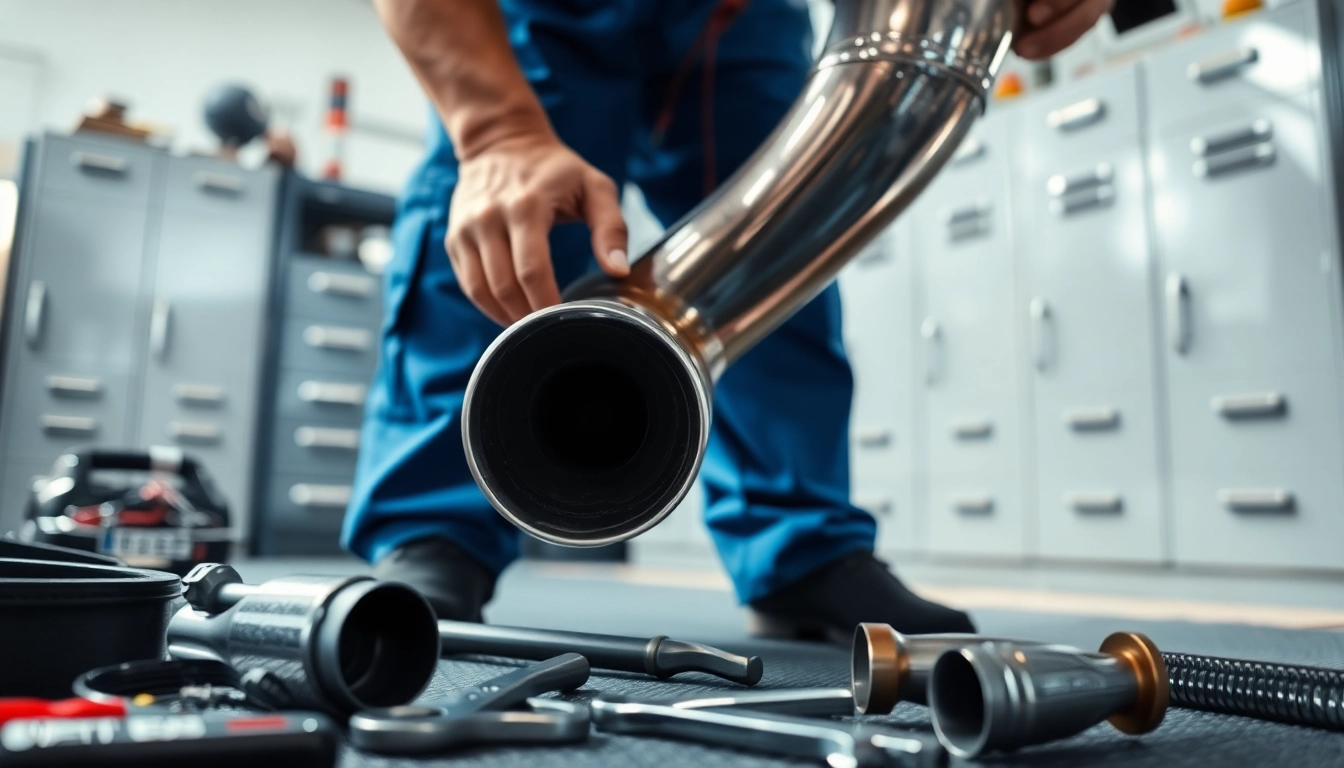Introduction to Exhaust Systems
The exhaust system is a crucial component of any vehicle, playing a significant role in its overall performance and efficiency. As the exhaust system manages the gases produced during combustion, understanding its functionality, types, and upgrades can vastly enhance your driving experience. This article delves into the essential aspects of exhaust systems, offering insights into their components, various types, the benefits of upgrading, installation considerations, and maintenance tips.
What Is an Exhaust?
At its core, the exhaust refers to the waste gases or air expelled from an engine, turbine, or similar machinery as a result of combustion. It comprises both a system of pipes and components that direct these exhaust gases away from the engine and out of the vehicle, ensuring that harmful emissions do not linger in the cabin. The exhaust not only serves to push waste gases out of the vehicle but also helps reduce engine noise and clean up emissions to comply with environmental regulations.
Importance of a Quality Exhaust
The significance of a quality exhaust cannot be understated. A well-designed exhaust system maximizes engine efficiency by ensuring that gases exit the combustion chamber freely, which directly contributes to improved power output. Furthermore, high-quality exhaust systems are essential for reducing harmful emissions, aiding in compliance with environmental standards. They also help achieve a desirable sound, enhancing the driving experience. Poorly functioning exhausts can lead to a range of issues, from decreased performance to failed emissions tests, making it crucial to invest in a quality system.
Components of Exhaust Systems
An exhaust system is composed of several key parts, each serving a specific function. Understanding these components can give vehicle owners insight into how their system works and what upgrades may be beneficial:
- Exhaust Manifold: Collects exhaust gases from the engine cylinders and directs them into the exhaust system.
- Oxygen Sensors: Monitor the exhaust gases to ensure optimal air-fuel mixture and improve engine efficiency.
- Catalytic Converter: Converts harmful emissions into less harmful substances before they are expelled into the atmosphere.
- Muffler: Reduces noise produced by the exhaust gases as they exit the vehicle.
- Exhaust Pipes: Convey exhaust gases from the engine to the rear of the vehicle, allowing them to exit into the atmosphere.
- Exhaust Tips: The visible end of the exhaust system, often adjustable for aesthetic purposes.
Types of Exhaust
Cat-Back Exhaust Systems
Cat-back exhaust systems replace everything from the catalytic converter back to the end of the exhaust pipe, including the muffler and exhaust tips. This type of system is popular among car enthusiasts looking for increased performance and improved sound. By replacing restrictive components within the factory system, cat-back systems reduce back pressure, allowing for a more efficient flow of exhaust gases and enhancing horsepower and torque levels. Additionally, they provide a significant enhancement in sound quality, offering a deeper, more aggressive exhaust note while remaining compliant with noise regulations.
Axle-Back Exhaust Systems
Axle-back systems are similar to cat-back systems but only replace components from the rear axle back. These systems are generally easier to install, making them a popular choice for those seeking a balance between performance and affordability. They can enhance the vehicle’s appearance with stylish exhaust tips and improve sound without entirely replacing the exhaust system. While axle-back setups may not provide as much of a performance bump as cat-back systems, they can significantly alter the vehicle’s auditory profile.
Performance Exhaust Options
For those seeking to maximize performance, various aftermarket options exist that cater to specific needs. Performance exhaust systems often feature mandrel-bent piping for smoother airflow, high-flow catalytic converters for improved emissions management, and larger diameter pipes to facilitate better gas evacuation. Additionally, these systems are typically crafted from stainless steel for enhanced durability and corrosion resistance. Installing a performance exhaust can lead to gains in horsepower and fuel efficiency, catering to both casual drivers and motorsport enthusiasts alike.
Benefits of Upgrading Your Exhaust
Improved Engine Performance
Upgrading your exhaust can lead to substantial improvements in engine performance. Higher efficiency in gas evacuation translates to better combustion and more power generated on the same amount of fuel. By reducing back pressure within the system, upgraded exhausts help engines breathe easier, resulting in increased horsepower and torque outputs. Improved performance is especially beneficial for vehicles used for towing or carrying heavy loads, as it can enhance acceleration and responsiveness.
Enhanced Sound Quality
A prominent benefit of exhaust upgrades is the enhanced sound profile. Many drivers find that a quality exhaust system gives their vehicle a more pleasing and aggressive sound, improving the overall driving experience. Exhausts can be fine-tuned to achieve a desired auditory profile, whether looking for a deep growl, a sporty rumble, or a more refined tone. This acoustic enhancement can provide a sense of connection between the driver and the vehicle, creating an engaging driving atmosphere.
Increased Fuel Efficiency
Another advantage of upgrading to a performance exhaust is potential increases in fuel efficiency. When exhaust gases can exit the engine more freely, the engine can operate more efficiently. Less resistance in the exhaust system means the engine doesn’t have to work as hard, which can lead to improved miles per gallon (MPG). This improvement can be especially relevant for drivers concerned about fuel costs and overall vehicle performance.
Installation Considerations
Choosing the Right Exhaust System
Selecting the right exhaust system depends on various factors, including the vehicle model, driving style, performance goals, and budget. It’s essential to consider what you want to achieve with an upgrade: are you aiming for better sound, improved performance, or aesthetic enhancements? Additionally, not all exhaust systems are created equal; they can differ significantly in quality and design. Researching different options, reading reviews, and consulting with professionals can help you make an informed decision.
DIY vs. Professional Installation
Deciding whether to install the exhaust yourself or seek professional help can depend on skill level and comfort with automotive repair. DIY installation can be cost-effective and rewarding, especially for those with mechanical experience. However, it is crucial to have the right tools and follow manufacturer instructions carefully to avoid complications. Hiring a professional can provide peace of mind, ensuring that the job is done correctly and efficiently, but it often entails additional costs. Weighing the pros and cons can help you make the best choice.
Common Installation Mistakes to Avoid
If you choose to install your exhaust system yourself, being aware of common mistakes can save you time and frustration. Here are several critical points to consider:
- Improper alignment of pipes can create leaks that reduce performance.
- Failing to use the recommended hardware or incorrectly tightening bolts can lead to system failure or exhaust leaks.
- Not checking for leaks post-installation can result in wasted time and effort if issues arise later.
- Neglecting to follow proper safety protocols can lead to injury.
Maintenance and Care for Your Exhaust
Regular Inspection Guidelines
Regular inspections of your exhaust system are essential to maintain its functionality and longevity. Signs of wear, damage, or rust should be addressed promptly. Ideally, you should inspect your exhaust system every six months or whenever performing routine vehicle maintenance. Look for any visible cracks, holes, or rust spots, and listen for any unusual noises while the engine is running. If you notice any decrease in performance or a change in sound, it’s worth investigating further.
Cleaning Your Exhaust System
Over time, deposits can accumulate within the exhaust system, affecting performance and sound quality. Regular cleaning can help mitigate this issue. Simple methods include using a wire brush to remove surface rust, applying a rust remover, or using commercial cleaning products specifically designed for exhaust systems. Ensuring the system is clean can improve airflow and prevent corrosion, thereby extending its life.
Signs You Need a Replacement
Recognizing when to replace your exhaust system can be critical for maintaining vehicle performance. Some signs indicate that it might be time for a replacement:
- Unusual noises, such as loud rumbling or hissing sounds from the exhaust could indicate a crack or leak.
- Visible damage or corrosion on exhaust pipes or components.
- A noticeable drop in fuel efficiency or engine performance.
- Increased emissions levels indicated by a failed emissions test.
Conclusion
The exhaust system plays a vital role in vehicle performance, sound, and compliance with emissions standards. Upgrading or maintaining your exhaust can lead to improved engine efficiency, better acoustics, and enhanced overall driving pleasure. Familiarity with the types of exhaust systems available, benefits of upgrading, and proper maintenance practices can empower you as a vehicle owner, making informed decisions that enhance your automobile’s functionality and longevity.



